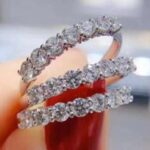In the world of digital displays and video walls, the demand for customized and visually striking solutions is ever-growing. One such innovative approach is the design of curved LED video walls. Unlike traditional flat installations, curved video walls offer a unique aesthetic appeal while maintaining full functionality. In this blog, we will explore the essential factors to consider when designing a curved LED video wall solution.

Why Choose curved LED Video Wall?
Enhanced Visual Experience:
The human eyeball has a certain curvature, and curved LED display screens are designed to align perfectly with this natural curve. This thoughtful design ensures that when you look at the screen, the visual information is conveyed to your eyes optimally. Whether you’re in the center of the viewing area or not, curved LED display screens offer a consistent and immersive visual experience.
Greater Flexibility:
In today’s world, most screens, whether they are on TVs, tablets, or laptops, are flat. However, there are instances where flat screens pose significant limitations. Take, for example, the design of a smartwatch; a flat screen might not be the best fit. This is where curved LED display screens come into play, offering flexibility by allowing the creation of specific curvatures to meet product requirements. Similarly, in the realm of large commercial spaces, transitional and all-encompassing IAMLEDWALL curved LED display screens are gaining popularity. They enable advertisers to make better use of space and convey information accurately to a larger audience.
Suitable Environments for curved LED Video Walls
curved LED video walls are not a one-size-fits-all solution. They are best suited for specific environments where their distinctive design and functionality can truly shine. Here are some key considerations:
a. Space Availability: Curved video walls are ideal for spaces with ample room, such as command centers and large exhibition halls. The impact of the curvature becomes more pronounced as the number of screens increases, typically with five columns or more.
b. Maintenance Space: Behind the video wall, there should be sufficient access for maintenance and servicing. This requirement significantly affects the overall spatial planning of the room.
c. Existing Curved Structures: In cases where the backdrop or wall itself has a curved design, opting for a curved video wall can create a harmonious and integrated look within the space.
Designing Curved Video Wall Solutions
When planning a curved LED video wall, several crucial aspects need to be carefully considered:
a. Curvature Degree: The degree of curvature plays a vital role in determining the visual impact of the video wall. Curvature typically ranges from 170 to 178 degrees, depending on the number of screens and the desired effect.
b. Support Structures: Collaborating closely with manufacturers to design appropriate support structures is essential. These structures should align perfectly with the chosen curvature, and creating visual mock-ups or diagrams can help ensure clarity and precision.
c. Seam Alignment: Achieving seamless alignment between the screens is a top priority. Skilled technicians must carefully adjust the seams to maintain a cohesive display.
d. Symmetry: Maintaining symmetry is critical for the overall aesthetics of the curved video wall. Ensuring that both sides of the curve look uniform is a meticulous task that requires high technical proficiency.
Pixel Pitch vs Resolution: Understanding the Difference
Conclusion
Curved LED video walls are a fantastic way to elevate the visual impact of a space, especially in environments where large-scale displays are essential. By paying close attention to the above tips, you can achieve a stunning and functional curved video wall that adds a touch of innovation and elegance to any setting.


